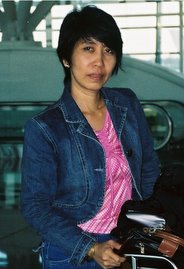
Theater and Reality: A Kagan Event
By Marili Fernandez-Ilagan
When I was first told about it, I thought it was strange.
“Casil, the husband, will be played by a woman dressed as a man,” Normaida Mamukid and the Kagan[1] women told me during the casting of the play “Pasaya (Beloved).” Collectively, they call themselves Sigay, which means rays of the sun. What an apt name for a theater group such as theirs.
But of course, theater has done cross-sexual representation as a matter of illusion. During the seventeenth century in the West, before women were totally admitted to the stage as actors, female roles were played by men who dressed as women. Later on in the century, in fact, the more daring among the women could only play a role in theater if they disguised as a man to trick the director.
As I was writing this piece, my daughter Wiccie, who happened to be the writer-director of a class play in
So here we have two interesting cultural items. On one hand, the Kagan women observe a particularly complex indigenous tradition in the practice of their religion, which could not be divorced from their other practices. “Pasaya” raised a concern: It is not Islamic for a man and a woman who are not real husband and wife to play such roles. Therefore, the actors had to be real husband and wife. The Miriam pupils, on the other hand, could not avail themselves of boy talents, though they are allowed to import from the neighboring
At some point in the rehearsal of “Pasaya,” however, an interesting development occurred. The Kagan women decided that Casil would be played by a man. And so, during the premiere performance of the play last December in a fishing farm in the tiny village of Piso in Banaybanay, Davao Oriental’s rice granary, a man it was who played Casil. It happened that they found a Muslim male who agreed to play the role, in spite of the religious prohibition. The play had begun to alter the Kagan women’s consciousness, a process that would go on in the making of the play. For one thing, the play dared to comment on domestic violence that was being perpetrated by the men in their society. Such incidents came as ordinary occurrences around them.
The Kagan women, in a matter of one month of rehearsals, changed their view of sexuality. For instance, religion prescribes that there should be no public show of intimacy between the sexes. But “Pasaya” required that a man and a woman be intimate because they played the roles of husband and wife. Theater represented a changing reality vis-à-vis religion. In their emerging theater, they strove to maintain their religious tradition – a norm, but ended up finding ways and means to break away from it. Theater thus became a duality of one.
Religious precepts in the Moro cultural and social system, to which the Kagan belong, clearly created the apprehension in the mounting of the play. The Kagan women hurdled it by casting a male as the husband. However, they made it a point that “husband” and “wife” would not as much as touch one another in the duration of the play. And so, there was never an instance when they disobeyed the Islamic value. This is a challenge for further study on the linkage of ethnicity and gender in Islamic society.
All told, the emerging theater of the Kagan women offered itself as a breakthrough in the struggle of ideas in an arena where women have hitherto played a submissive role. While my daughter and her Miriam classmates could undoubtedly outgrow their timidity towards boys in due time, would the outcome of the Kagan women’s theatre change their real-life stereotyped roles? Abangan.
[1] The Kagan are among the original inhabitants of the
[2] Aladdin is a Disney production about a commoner named Aladdin and his monkey Abu. Aladdin’s life changes with one rub of a magi lamp, releasing the Genie.

No comments:
Post a Comment